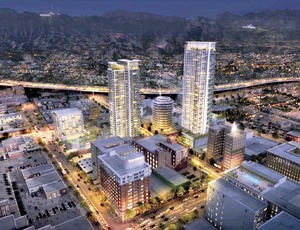

Los Angeles city planners are so eager to redevelop the iconic Hollywood district that, according to a recent lawsuit, they approved a $650-million development that sits dangerously close to—or possibly on top of—the active Hollywood fault. The suit was filed against the city by Stop the Millennium Hollywood Project to prevent construction of the planned 4.7-acre complex, which includes two new high-rises.
In an email that is an exhibit in the case, James Dolan, assistant professor of earth sciences at the University of Southern California and a specialist in global fault systems, says the Hollywood fault is one of the best-known active faults in earthquake-prone California. The City Council, however, ignored warnings from Dolan and city geologist Dana Prevost. It also ignored a map from the project's geotechnical consultant, Langan Engineering, showing the fault through the site, says John Schwada, a spokesman for the group that filed the suit.
In July, the City Council approved the project. The suit was filed on Aug. 28 in Los Angeles Superior Court. A preliminary hearing is set for after Jan. 1.
The suit claims the city-approved environmental impact review (EIR), submitted by developer Millennium Partners, was inadequate. Robert P. Silverstein, the lawyer for the development's opponents, says Langan originally produced a map showing the city's "fault-rupture study area" running through the site. For the approvals process, the map was altered to show the project outside the critical zone, he alleges. The city should have known the map was altered, he says.
Langan says it prepared the investigation in accordance with city planning department requirements. "Additional studies have been requested, so opinions by others on the findings to date would be premature," says Dan Eberhart, the Langan associate who prepared the EIR's geotechnical section. He would not clarify whether the original study found the fault to be running directly through the site.
While the Millennium Hollywood has generated most of the controversy, the $200-million residential BLVD 6200 is already under construction on or near active splays of the fault.
State geologist John Parrish says Caja Environmental Services did not perform a geological hazard investigation before construction. "If these projects are too close to a fault but still being approved, the city is going to have to review its permitting requirements," says Parrish.
"If a building is projected to be built near, or through, an active fault zone, we would want to have studies performed and there to be an active geological investigation," he adds.
"The Hollywood fault has a surface expression, and it's my understanding that the BLVD 6200 building is placed right up against it," says Parrish.
If the Millennium is found to be directly above a splay of the fault, it might have to be relocated or abandoned. State law stipulates that no party can build on top of an active fault line for human habitation, says Parrish.
Douglas Thompson, president of the Structural Engineers Association of Southern California, says that some fault lines are simply too big to build directly on top of, but he says it is a "judgment call" of the geotechnical engineer. "We get asked by owners all the time why some of these buildings are so expensive, and we have to say, 'Because it's right next to an active fault,' " he says.
Further, he says, there is often debate about the techniques used to identify a fault line and estimate potential movement. "Sometimes, there are disagreements," says Thompson.

Post a comment to this article
Report Abusive Comment